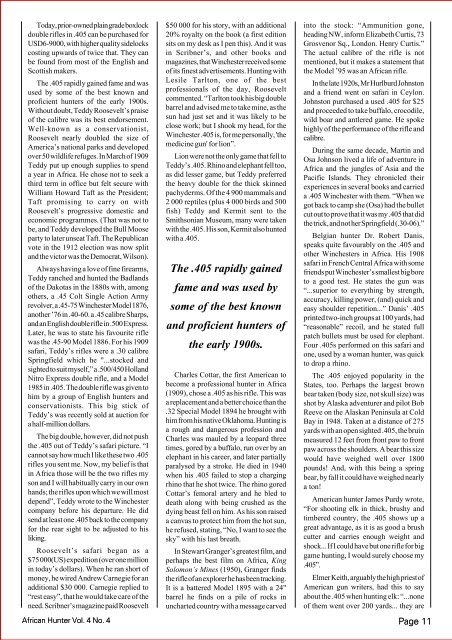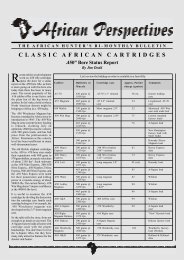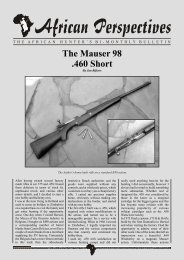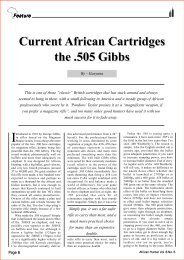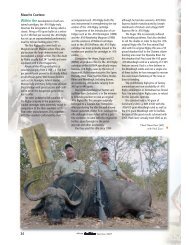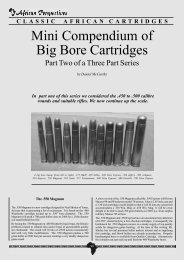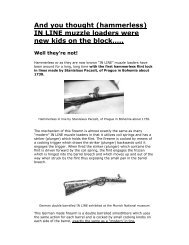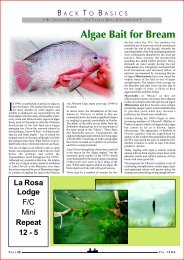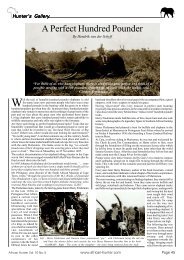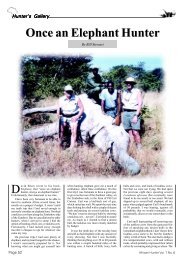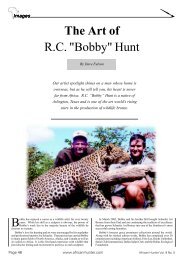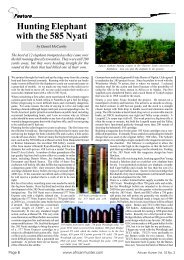America's First African Cartridge Feature - HuntNetwork
America's First African Cartridge Feature - HuntNetwork
America's First African Cartridge Feature - HuntNetwork
You also want an ePaper? Increase the reach of your titles
YUMPU automatically turns print PDFs into web optimized ePapers that Google loves.
Today, prior-owned plain grade boxlock<br />
double rifles in .405 can be purchased for<br />
USD6-9000, with higher quality sidelocks<br />
costing upwards of twice that. They can<br />
be found from most of the English and<br />
Scottish makers.<br />
The .405 rapidly gained fame and was<br />
used by some of the best known and<br />
proficient hunters of the early 1900s.<br />
Without doubt, Teddy Roosevelt’s praise<br />
of the calibre was its best endorsement.<br />
Well-known as a conservationist,<br />
Roosevelt nearly doubled the size of<br />
America’s national parks and developed<br />
over 50 wildlife refuges. In March of 1909<br />
Teddy put up enough supplies to spend<br />
a year in Africa. He chose not to seek a<br />
third term in office but felt secure with<br />
William Howard Taft as the President;<br />
Taft promising to carry on with<br />
Roosevelt’s progressive domestic and<br />
economic programmes. (That was not to<br />
be, and Teddy developed the Bull Moose<br />
party to later unseat Taft. The Republican<br />
vote in the 1912 election was now split<br />
and the victor was the Democrat, Wilson).<br />
Always having a love of fine firearms,<br />
Teddy ranched and hunted the Badlands<br />
of the Dakotas in the 1880s with, among<br />
others, a .45 Colt Single Action Army<br />
revolver, a .45-75 Winchester Model 1876,<br />
another ’76 in .40-60. a .45 calibre Sharps,<br />
and an English double rifle in .500 Express.<br />
Later, he was to state his favourite rifle<br />
was the .45-90 Model 1886. For his 1909<br />
safari, Teddy’s rifles were a .30 calibre<br />
Springfield which he "...stocked and<br />
sighted to suit myself,” a .500/450 Holland<br />
Nitro Express double rifle, and a Model<br />
1985 in .405. The double rifle was given to<br />
him by a group of English hunters and<br />
conservationists. This big stick of<br />
Teddy’s was recently sold at auction for<br />
a half-million dollars.<br />
The big double, however, did not push<br />
the .405 out of Teddy’s safari picture. “I<br />
cannot say how much I like these two .405<br />
rifles you sent me. Now, my belief is that<br />
in Africa those will be the two rifles my<br />
son and I will habitually carry in our own<br />
hands; the rifles upon which we will most<br />
depend”, Teddy wrote to the Winchester<br />
company before his departure. He did<br />
send at least one .405 back to the company<br />
for the rear sight to be adjusted to his<br />
liking.<br />
Roosevelt’s safari began as a<br />
$75 000(US) expedition (over one million<br />
in today’s dollars). When he ran short of<br />
money, he wired Andrew Carnegie for an<br />
additional $30 000. Carnegie replied to<br />
“rest easy”, that he would take care of the<br />
need. Scribner’s magazine paid Roosevelt<br />
$50 000 for his story, with an additional<br />
20% royalty on the book (a first edition<br />
sits on my desk as I pen this). And it was<br />
in Scribner’s, and other books and<br />
magazines, that Winchester received some<br />
of its finest advertisements. Hunting with<br />
Lesile Tarlton, one of the best<br />
professionals of the day, Roosevelt<br />
commented. “Tarlton took his big double<br />
barrel and advised me to take mine, as the<br />
sun had just set and it was likely to be<br />
close work; but I shook my head, for the<br />
Winchester .405 is, for me personally, 'the<br />
medicine gun' for lion”.<br />
Lion were not the only game that fell to<br />
Teddy’s .405. Rhino and elephant fell too,<br />
as did lesser game, but Teddy preferred<br />
the heavy double for the thick skinned<br />
pachyderms. Of the 4 900 mammals and<br />
2 000 reptiles (plus 4 000 birds and 500<br />
fish) Teddy and Kermit sent to the<br />
Smithsonian Museum, many were taken<br />
with the .405. His son, Kermit also hunted<br />
with a .405.<br />
The .405 rapidly gained<br />
fame and was used by<br />
some of the best known<br />
and proficient hunters of<br />
the early 1900s.<br />
Charles Cottar, the first American to<br />
become a professional hunter in Africa<br />
(1909), chose a .405 as his rifle. This was<br />
a replacement and a better choice than the<br />
.32 Special Model 1894 he brought with<br />
him from his native Oklahoma. Hunting is<br />
a rough and dangerous profession and<br />
Charles was mauled by a leopard three<br />
times, gored by a buffalo, run over by an<br />
elephant in his career, and later partially<br />
paralysed by a stroke. He died in 1940<br />
when his .405 failed to stop a charging<br />
rhino that he shot twice. The rhino gored<br />
Cottar’s femoral artery and he bled to<br />
death along with being crushed as the<br />
dying beast fell on him. As his son raised<br />
a canvas to protect him from the hot sun,<br />
he refused, stating, “No, I want to see the<br />
sky” with his last breath.<br />
In Stewart Granger’s greatest film, and<br />
perhaps the best film on Africa, King<br />
Solomon’s Mines (1950), Granger finds<br />
the rifle of an explorer he has been tracking.<br />
It is a battered Model 1895 with a 24"<br />
barrel he finds on a pile of rocks in<br />
uncharted country with a message carved<br />
into the stock: “Ammunition gone,<br />
heading NW, inform Elizabeth Curtis, 73<br />
Grosvenor Sq., London. Henry Curtis.”<br />
The actual calibre of the rifle is not<br />
mentioned, but it makes a statement that<br />
the Model ’95 was an <strong>African</strong> rifle.<br />
In the late 1920s, Mr Hurlburd Johnston<br />
and a friend went on safari in Ceylon.<br />
Johnston purchased a used .405 for $25<br />
and proceeded to take buffalo, crocodile,<br />
wild boar and antlered game. He spoke<br />
highly of the performance of the rifle and<br />
calibre.<br />
During the same decade, Martin and<br />
Osa Johnson lived a life of adventure in<br />
Africa and the jungles of Asia and the<br />
Pacific Islands. They chronicled their<br />
experiences in several books and carried<br />
a .405 Winchester with them. “When we<br />
got back to camp she (Osa) had the bullet<br />
cut out to prove that it was my .405 that did<br />
the trick, and not her Springfield (.30-06).”<br />
Belgian hunter Dr. Robert Danis,<br />
speaks quite favourably on the .405 and<br />
other Winchesters in Africa. His 1908<br />
safari in French Central Africa with some<br />
friends put Winchester’s smallest big bore<br />
to a good test. He states the gun was<br />
“...superior to everything by strength,<br />
accuracy, killing power, (and) quick and<br />
easy shoulder repetition...” Danis’ .405<br />
printed two-inch groups at 100 yards, had<br />
“reasonable” recoil, and he stated full<br />
patch bullets must be used for elephant.<br />
Four .405s performed on this safari and<br />
one, used by a woman hunter, was quick<br />
to drop a rhino.<br />
The .405 enjoyed popularity in the<br />
States, too. Perhaps the largest brown<br />
bear taken (body size, not skull size) was<br />
shot by Alaska adventurer and pilot Bob<br />
Reeve on the Alaskan Peninsula at Cold<br />
Bay in 1948. Taken at a distance of 275<br />
yards with an open sighted .405, the bruin<br />
measured 12 feet from front paw to front<br />
paw across the shoulders. A bear this size<br />
would have weighed well over 1800<br />
pounds! And, with this being a spring<br />
bear, by fall it could have weighed nearly<br />
a ton!<br />
American hunter James Purdy wrote,<br />
“For shooting elk in thick, brushy and<br />
timbered country, the .405 shows up a<br />
great advantage, as it is as good a brush<br />
cutter and carries enough weight and<br />
shock... If I could have but one rifle for big<br />
game hunting, I would surely choose my<br />
.405”.<br />
Elmer Keith, arguably the high priest of<br />
American gun writers, had this to say<br />
about the .405 when hunting elk: “...none<br />
of them went over 200 yards... they are<br />
<strong>African</strong> Hunter Vol. 4 No. 4 Page 11


